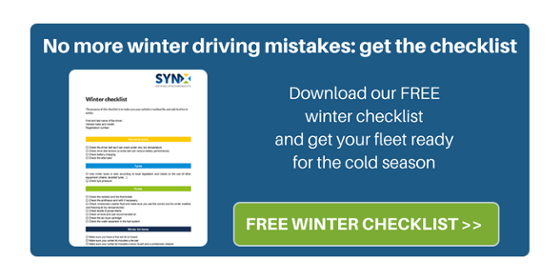
Some of you might think it too early for a winter driving reminder as the summer and autumn seasons have been particularly warm in both the UK and Ireland, but if you are involved in vehicle management, you probably know that it’s never too early, as preparation is key, and you should always expect the unexpected.
What has been up until now one of the warmest autumns in ages is still no indication of a mild winter to come. Checking past trends in terms of weather is not a reliable basis for predicting what lies ahead, especially considering the erratic patterns of the last few years. Every year’s seasonal weather looks increasingly unpredictable. In other words, following seasonal trends to plan for winter maintenance, getting vehicles ready for ice, fog and snow (if applicable) is no longer a guarantee, and fleets are often urged to equip fleets with their winter gear at short notice, as soon as the weather changes (which usually happens suddenly).
It is important then to follow some strategies in order for the fleet to be ready as soon as the first cold days kick in, both from an equipment point of view and also regarding winter driving techniques. So what can fleets do in order not to get caught off guard?
- Monitor the official meteorological services’ websites. Official websites such as Met Éireann for Ireland and the Met Office in the UK are the most reliable sources of information relating to upcoming cold (or warm) spells and will alert you to any potentially serious weather conditions such as storms, gales, ice and so on. This can help you decide how to make good on particular deliveries or appointments, at least with regards to the routes that your fleets should choose when travelling.
- Use spare time to carefully check on your vehicles’ most sensitive components. Some vehicle parts are more likely to suffer from wear and tear or be overused during winter. We are thinking for example about tyres, as you might either check their thread depth (the recommendations for winter are around 3 mm) or, if changing to a different tyre type, depending on your area of operation, your travelling destinations or the specific vehicles in use, you might opt for winter tyres or 4-season tyres. Other items that also have to be considered carefully are lights, windscreen wipers and de-icing equipment. Severe winter weather should never compromise visibility, so all vehicle components should function properly and be ready to deal adequately with rain, fog or snow.
- Make sure all vehicles have a winter kit. Vehicles in winter should all be provided with a series of items that are of use in the event of harsh winter weather. Better yet, save some time by having drivers check if the kit in their vehicle is in order and schedule some training to look over it and refresh them on defensive driving behaviour. For example, in any weather condition it is important to respect safety distances, but in adverse weather it is especially crucial, so make sure you use this opportunity to brush up on best practices for winter driving.
- Use your telematics system as a trusty ally. Telematics system will help you schedule vehicle preparation for winter and winter maintenance, but will also give you the opportunity to check routes in advance and privilege routes that are less likely to be compromised by severe weather conditions or which are experiencing lighter traffic—winter roads tend to be more congested due to the fact that drivers need to adjust their driving style to the weather conditions.



